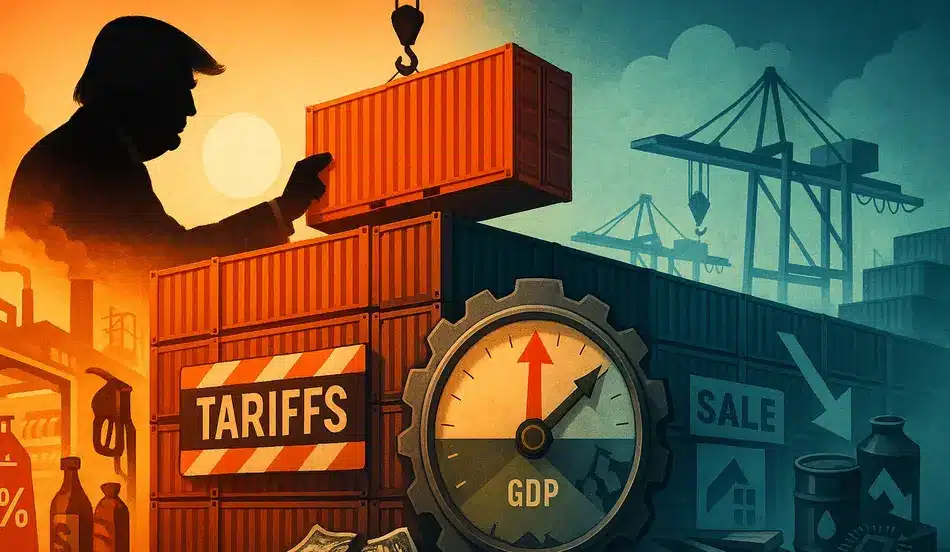As U.S. trade policy leans on threats and tariffs, global trade realigns — with troubling consequences for America’s economy. Former President Donald Trump’s trade strategy is once again back in the spotlight — and this time, the numbers show a paradox emerging: inflation inside the U.S., deflation elsewhere, and a rising risk of stagflation.
For months, Trump’s approach has centered on negative incentives — punitive tariffs, sanctions, and threats — rather than positive inducements. This, according to critics, has left the U.S. increasingly isolated in a shifting global economy.
From Positive to Negative Incentives
Governments can influence behavior in two ways:
- Positive incentives — rewards for cooperation.
- Negative incentives — punishments or threats for non-compliance.
Trump, after watching prior administrations fail to achieve their trade goals through positive incentives, has leaned heavily on the second approach.
- Tariffs on allies and rivals alike
- Sanctions on multiple countries
- Threats of “reciprocal” tariff hikes
- Diplomatic pressure bordering on interference in other nations’ politics
Critics say these tactics reflect not strength but a deeper reality: the U.S. is struggling to adapt to a world where its economic leverage is diminished.
Tariffs Shifting the Hiring Landscape? Stay Ahead.
Trade policies are reshaping costs, demand, and talent flows. WhatJobs connects you with the right candidates before the market shifts again.
Post a Job Now →The Limits of U.S. Influence
Some analysts argue the problem isn’t the specific strategy but the underlying shift in global power. In short: the American empire is over, and Washington hasn’t come to terms with it.
Where U.S. pressure once carried decisive weight, now many countries — like India under Prime Minister Narendra Modi — pursue domestic and regional priorities largely independent of Washington’s demands.
This leads to overreach: attempts to force compliance that either fall flat or produce unintended consequences.
China’s Countermove
The most striking example comes from China’s trade performance in recent months.
According to newly released trade data:
- Chinese exports to the U.S. have declined due to tariffs.
- Chinese exports to the rest of the world have risen sharply, more than offsetting U.S. losses.
By diversifying export markets — particularly across Asia — China has blunted the impact of U.S. tariffs and, in the process, encouraged other nations to deepen their trade ties with Beijing.
Deflation in the Global South
This shift has a knock-on effect: excess supply in non-U.S. markets.
When goods previously destined for the U.S. are redirected elsewhere without a matching rise in demand, prices in those markets tend to fall.
The result?
- Deflationary pressures in much of the Global South and parts of Asia.
- Inflationary pressures inside the U.S., as tariffs drive up prices for imported goods.
The Inflation–Deflation Divide
This split is dangerous for America’s manufacturing ambitions.
If the U.S. becomes the inflationary core of a deflationary global economy, it will be much harder to convince companies to relocate production to U.S. soil. Rising domestic costs make the U.S. less attractive as a production hub, even for firms seeking to diversify away from China.
Corporate Commitments vs. Reality
While some companies announce massive investment plans in the U.S. — sometimes citing figures like $400 billion over 4–10 years — the timelines are carefully chosen.
Many of these commitments stretch beyond the current political cycle, allowing corporations to delay or downsize projects if economic conditions sour.
Early Signs of Recession
Recent U.S. employment data offers more warning signs:
- Job figures for the prior two months were revised downward.
- The most recent month’s numbers were weaker than expected.
- The official who released the data was abruptly dismissed — underscoring the political sensitivity.
These trends point to recessionary pressures, which, combined with the inflation triggered by tariffs, create a textbook recipe for stagflation: stagnant growth plus rising prices.
The Stagflation Threat
Stagflation is particularly challenging for policymakers because the tools used to fight inflation (raising interest rates) can deepen a recession, while the tools to fight recession (stimulus spending, lower rates) can fuel inflation.
If the U.S. continues to face:
- Tariff-driven price increases
- Global deflationary spillovers
- Weak domestic job growth
…then it risks entering a prolonged period of economic stagnation that is politically and economically destabilizing.
Key Takeaways
- Trump’s heavy reliance on tariffs and sanctions represents a shift toward negative incentives in U.S. trade policy.
- China’s success in redirecting exports undermines the effectiveness of U.S. tariffs.
- The global economy is splitting into inflationary U.S. markets and deflationary non-U.S. markets.
- This divergence makes it harder to attract manufacturing investment back to the U.S.
- The combination of slowing growth and rising prices raises the specter of stagflation.
Bottom line: The U.S. may be overestimating the leverage of its trade threats in a world where supply chains are more flexible, alternative markets are plentiful, and American economic dominance is no longer guaranteed. Without a recalibration of strategy, the result could be a dangerous blend of inflation, recession, and diminished global influence.
Frequently Asked Questions
1. What is the main risk of Trump’s current tariff strategy?
The biggest risk is stagflation — a combination of stagnant economic growth and rising prices — fueled by tariff-driven inflation in the U.S. and global trade realignment.
2. Why are Chinese exports rising despite U.S. tariffs?
China has successfully redirected exports to other markets, especially in Asia, offsetting the losses from reduced sales to the United States.
3. How can global deflation hurt U.S. manufacturing plans?
If the U.S. remains inflationary while other regions experience deflation, companies are less likely to move production to America due to higher operating costs.
4. What’s the link between tariffs and inflation?
Tariffs raise the cost of imported goods, and businesses often pass these costs on to consumers, leading to higher overall prices.




